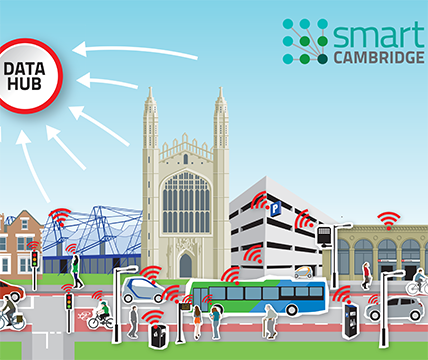Case study: Smart Cambridge
When you’ve been awarded public funds to the tune of £500 million to transform the economy in your region, where do you start?
That was the problem facing Cambridge City Council, Cambridgeshire County Council and South Cambridgeshire District Council in 2014. Transportation and housing issues had long been recognised as holding the region back, so physical infrastructure was going to be a major focus. But digital infrastructure would also play a key role – if it lagged behind, no amount of spending on roads, railways and housing would make the significant degree of difference that the situation demanded.
Academic brought in as a consultant
The three local authorities knew they had a unique resource on their doorstep: the University of Cambridge. A meeting with Dr Ian Lewis, Director of Infrastructure Development, brought the University into the project as a partner, enabled by Cambridge Enterprise’s Consultancy Services.
‘The mutual benefits of working together are obvious,’ Lewis says. ‘Both the region and the University need a digital infrastructure that is fit for purpose. The region has a fantastic opportunity to lead the way in smart cities, and the University has the world-leading researchers who can help to make that happen. We know that autonomous cars are on the way; the ultimate goal is the autonomous city.’
The Intelligent City Programme
As a result of this collaboration, the Intelligent City Programme was launched in March 2017. Thousands of sensors were set up in and around the region. Some transport data was already being collected, for instance from car park barriers and traffic lights, but the project added new sensors to monitor air quality and measure cycle and pedestrian movements. Two purpose-built networks were set up to gather the billions of data points being generated. But gathering data was just the start.
Although many cities are working to develop their digital infrastructure, there is often a disconnect between gathering data and what is done with that data. Using sensors to track traffic in real time, a typical example, only tells you where the traffic jams are now and, if you are already stuck in a jam, being told it’s there is hardly helpful. Nor does real-time data provide all the answers when planning for the future unless there is a sophisticated layer of research and analysis on top of it.
Multi-disciplinary University involvement
With the help of Cambridge Enterprise, Dr Lewis was not only able to dedicate staff to analysing the data, but also to expand participation in the Smart Cambridge Intelligent City Programme across the University. Architecture, chemistry, computing, engineering, manufacturing and land economy are just a few of the disciplines that have been involved, and to date around 250 researchers at the University of Cambridge, many of them world leaders in their field, have used the data for their work.
‘Researchers are not only working with the data we’re collecting,’ Lewis says. ‘They’re also finding ways to collect better data. A group in the Engineering Department, for instance, are tackling the challenge of developing particulate sensors that don’t clog up and provide more detailed and accurate information about air quality.’
The local business community
The project has also expanded to involve the business community as well. ‘One example where sensor data could be used to save fuel and reduce air pollution is commercial waste collection,’ Lewis points out. ‘Sensors in commercial bins could indicate when they need emptying, and real-time traffic information could be used to direct waste collection vehicles via the most efficient route.’ But this is not a trivial ask, and a competition for small and medium enterprises has resulted in 25 different sensor deployment projects in the region working on this and other problems.
Through Dr Lewis and Cambridge Enterprise, the University has been able to collaborate with three local regional authorities and local businesses to create a highly sophisticated, collaborative and inclusive smart city programme. The multi-disciplinary approach is ensuring that all the key players are involved in bringing the goal of the autonomous city that much closer.




